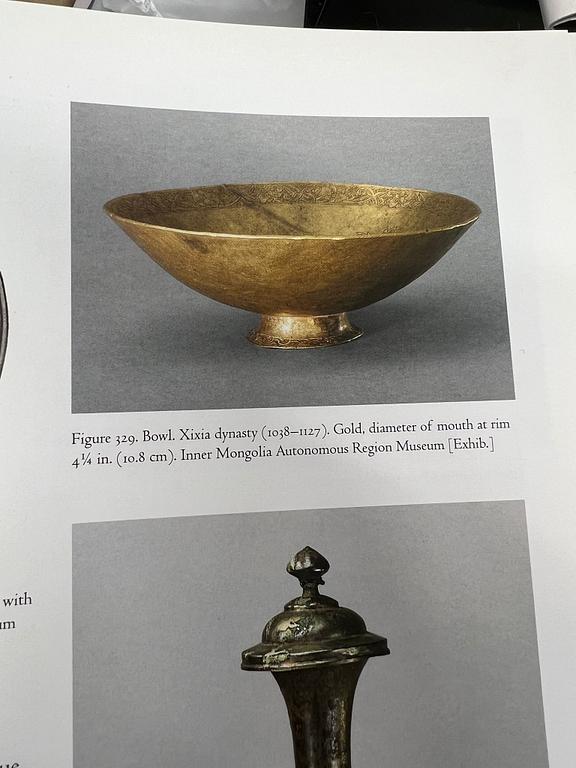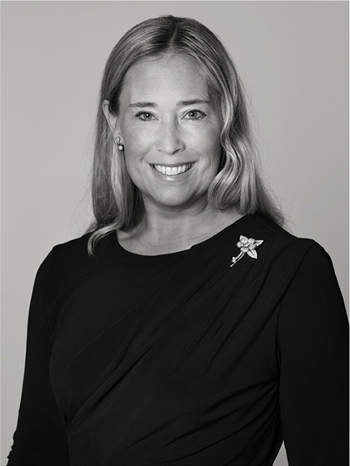A rare gold vase, China or Central Asia, 12th-14th century.
The slightly compressed globular body is standing on a splayed foot, tall neck with flared rim. The outside is decorated with bands of floral scroll by the rim and the shoulder and in between further continuous flowers. Height 9.5 cm. Weight 156.2 gram.
Surface is tested with probing fluid by Bukowskis Gemmologist and its positive to a gold content of 21.6 K gold or above.
Provenance
The Carl Kempe Collection.
Bukowskis is privileged to offer a selection of Chinese gold, silver, and gilt-bronze works of art, dating from the Six Dynasties to the Ming Dynasty, from the collection of the eminent collector, Carl Kempe (1884-1967) and offered by his family.
The Swedish industrialist Carl Kempe was a leading figure of the Swedish pulp and paper industry, as well as an accomplished tennis player who won a silver medal at the 1912 Summer Olympics in Stockholm. Today he is better known internationally as a famed collector of Chinese antiquities.
Carl Kempe’s interest in Chinese art began in the early 1920s. He belonged to a group of Chinese art connoisseurs who began collecting in the early 20th century; he was also a member of the China Committee, created by HRH Gustav Adolf, later HRH King Gustav VI Adolf of Sweden, Torsten Laurin, Johan Gunnar Andersson, Axel Carlander and Axel Lagrelius amongst others to acquire art from China. The China Committee later transformed into the China Club in Stockholm (a local branch of the Oriental Ceramic Society in London).
Delving into Carl Kempe’s inventories from the 1920’s and onwards one can see that he acquired items from Paris dealers such as C. T. Loo, Monsieur N. Knudsen and Monsieur L. Michon, and from London dealer Bluett & Sons, Sydney L. Moss, Yamanaka & Co., John Sparks, Mr Peter Boode, Mr Norton, K. Shimuzu, Spink & Son, Beijing dealers Wang Chia Yu and Cang I Chen, from Shanghai E. T. Chow, and from Stockholm dealers Hans Öström, C. E. Gadelius, Orvar Karlbeck, and the Karlbeck Consortium.
Following his initial interest in Chinese art in the 1920s, Carl Kempe and his wife travelled to China in 1935-1936, were he met up with the other famed Swedes out there such as Johan Gunnar Andersson, whose expeditions, and excavations he sponsored. In China it has been reported that he purchased some 250 items of Chinese art.
Kempe had been attracted to Qing dynasty polychrome porcelains initially, but he later developed a particular interest in white-glazed ceramics – especially those from the Tang-Song period.
The other area in which he developed a great interest in and subsequently formed a spectacular collection, was Chinese gold and silver, which ranged from the Bronze Age Zhou dynasty to the Qing dynasty.
His third area of specialised collecting was Chinese glass, that he bequeathed to the Östasitiska Museet in Stockholm, although he also acquired fine examples of Chinese lacquer, enamels, bronzes, and other items, as well expanding his interests to Roman, Egyptian, Islamic and Etruscan glass, and gold.
He also loaned pieces from the collection to several international exhibitions, for example, to the ‘Ausstellung der Vereinigung der Freunde Ostasiatischer Kunst, Köln, 1926,
the famous 1935-36 International Exhibition of Chinese Art in London (see listing on page xxxi index of lenders). His good friend J. G. Andersson gave a lecture at the Royal Society, Burlington House, December 5th, 5 P.M. "The Goldsmith in Ancient China". The Arts de la Chine Ancienne, Musee de L’Orangerie, Paris, 1937. After this exhibition he seems to have purchased some gold items that was on loan by Madame de Wannieck, Paris. He also lends a good number of items to the exhibition in Copenhagen ‘Kinas Kunst i Svensk og Dansk eje, det danske Kunstindustrimuseum, Kobenhamn’, 1950.
As an enthusiastic, academic collector (he described himself as a manic collector), Kempe welcomed scholars and collectors from all over the world, to view, discuss and research his remarkable collection and collected to end of his days. Kempe sponsored numerous research projects and excavations and was a true patron of the arts and made numerous donations to Östasiatiska Museet in Stockholm.
After his death in 1967 the collection continued to be displayed at his residence at Ekolsund Castle, and in the 1970s his daughters followed their father’s footsteps and agreed to lend some 150 items of ceramics, gold, and silver from the Kempe collection. So, they were sent on a touring exhibition in the United States in collaboration with The Asia Society and the Smithsonian, published by Bo Gyllensvärd, who wrote his PhD on the Collection, in Chinese Gold and Silver and Porcelain - The Kempe Collection, 1971.
In 1997 a large part of the Kempe collection of ceramics, gold and silver was sold to the Museum of Art and Far Eastern Antiquities in Ulricehamn. Some ten years later the collection was sold at auction and part of them were auctioned at a sale entitled Masterpieces of Chinese Precious Metalwork: Early Gold and Silver, held by Sotheby’s London on 14 May 2008.
The objects now on offer have remained with Kempe family – and are now offered for sale by the family.
Exhibitions
Marked with Carl Kempe’s inventory no CK454.
Compare another gold vessel from the Carl Kempe Collection sold at Sotheby’s, 14 May 2008 • London. Masterpieces of Chinese Precious Metalwork, Early Gold, and Silver; Early Chinese White, Green and Black Wares /Lot 104. That vessel is dated as Song dynasty, and was according to a note by Osvald Siren, saved in the inventory of Östasiatiska museet, Stockholm, archive no 111761, found in Shansi, in 1924. Weight 72 gram.
Compare also in the same sale another Zhadou, Lot 73.
Literature
Die sammlung Pierre Uldry, Chinese Gold und Silber, Zurich 1994. Compare a Gold vessel with similar decoration, lot 286.
James C. Y. Watt. The World of Khubilai Khan, Chinese Art in the Yuan dynasty. The exhibition focused on works made during the Mongol rule in China, which began with Chinggis Khan’s capture of the capital of the Jin dynasty in 1215 and extended through the Yuan dynasty. Metropolitan Museum, New York, 2010. Compare with a bowl on page 287, figure 329, dated to Xixia dynasty (1038-1127), Inner Mongolia Region Museum.
Han Wei, Christian Deidier, Ancient Chinese Gold, Paris 2001. Compare with other gold vessels, depicted on page 205. Liao and Tang dynasty.
Bo Gyllensvärd, 'T'ang Gold and Silver', Bulletin of the Museum of Far Eastern Antiquities, Compare no. 29, 1957, figs. 27a, 97r.







































































